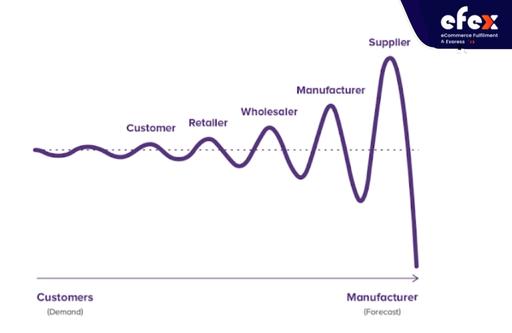
More Helpful Content
As a company owner, you are aware of how your supply chain is directly impacted by the demand for your goods and services.
No matter how well a company offers its goods and services, customer demand and sales will change over time. Nevertheless, Companies can prepare their supply networks to prevent negative effects by foreseeing developments.
Demand is changing dramatically as a result of businesses and consumers alike shifting their spending behavior. These variations can result in higher expenses, lower revenues, more risk, and worse profit margins if they are not appropriately handled.
With this in mind, demand variability has been one of the top 3 issues in driving the business, according to a 2020 research of supply chain leaders. The success of a business and the efficiency of your supply chain depend on how you handle demand fluctuation.
So, how to deal with the challenge of demand variability? Let's learn more in this article below.
Demand variability assesses the fluctuation in customer demand for a business. It determines the variance between the company's anticipated result and the customer demand in reality.

Demand fluctuation is influenced by a number of variables, including:
These elements make demand fluctuation one of the most difficult problems for businesses to solve along the whole supply chain. Demand variability can seriously disrupt the supply chain if it is not properly managed.
To improve prospective sales, a corporation could raise its inventory orders if it anticipates a rise in customer demand.
Nonetheless, the warehouse, distributors, and retailers are all left with excessive stock if the actual consumer demand does not match the forecast. In addition to raising storage costs, this exposes the risk of producing dead stock.
If a company has an unanticipated rise in customer demand, it must locate a supplier quickly who can satisfy the order.
👉 Read More: Reorder Point (ROP): Formula and How to calculate it
For businesses to solve these issues and the difficulty of demand fluctuation, new predictions, demand response, as well as manufacturing operations management methods and technologies must be identified and then used.
Supply chain professionals are aware that demand fluctuation at the level of the finished product causes the "Bullwhip" impact upstream.
Supply Chain Management uses a phrase called "Bullwhip Effect" to characterize the fluctuation. This phrase describes the significant fluctuations in inventory as a result of variations in consumer demand.

Inventory as well as other resources must be maintained anticipating need because it is impossible to forecast client demand. These forecasting techniques rely heavily on statistical data, some of which may not be reliable. The producers have a safety supply in their warehouses to combat this.
Not only should forecasting be used to manage demand, but also should effective planning be used to manage all departmental operations.
Depending on how many echelons there are between the end consumer and the supply chain, this influence grows.
For instance, the impact is negligible if OEMs - Original Equipment Manufacturers are linked directly to Tier 1 providers.
The bullwhip effect, however, might become quite unpleasant if the final consumer uses distribution channels that depend on manufacturing businesses, which in turn depend on contract suppliers and manufacturers.
Assessing and placing the merchandise in the proper location is one technique to reduce the number of multi-echelon whiplashes. Monitor the material flow instead of interacting with upstream providers about the final consumer.
Find the nearest replenishment location if you are serving the consumer from stock. To choose the best inventory for such a loop, consider the inventory velocity, utilization, lead times, as well as coefficient of variation.
For each tier, comparable computations should be made. By doing this, multi-tier variability is reduced to one tier at a given time.
Efex has developed a system to handle these supply chain loops. Because of the advantages of these designs for Efex product modules, our clients see significant gains in terms of customer service levels and average inventory levels for finished goods and raw materials.
At all levels of maturity, demand variability is usually acknowledged as one of the biggest obstacles to successful supply chain management. The four main factors that affect demand variability are volatility, uncertainty, complexity, challenge, and ambiguity.
Dealing with the so-called "bullwhip effect" offers a huge and very expensive problem for many supply chain leaders.
The effect of this rapid demand increases as it flows upstream in the supply chain when there are significant swings in inventory as a result of panic purchasing.
Empty shop shelves encourage far more panic shopping, which hurts merchants' chances of making sales, causes distributors to scurry to decide who will get what of a product, and overwhelms producers with these rapid, unforeseen demand surges.
👉 Read More: Backorder Cost: Meaning, Importance and Formula
Therefore, supply chain executives' success depends on being knowledgeable and adaptable enough to foresee and fulfill inventories in the appropriate areas, at the right place, and at the correct time whenever the market detects a rapid spike in demand, particularly during times of international crisis.
However, even the strongest contingency preparations might not be sufficient in the event of something like a pandemic (COVID-19).

The management of demand variability needs to be adaptable in order to cope with unforeseen changes. Additionally, companies should actively work to reduce their demand variability by:
The main suppliers of a firm should be fully aware of the anticipated demand so they may adjust their internal procedures.
Vendors may prepare safety stock, organize logistics in advance, and enhance customer response by ensuring complete transparency. Maintaining an efficient workflow is made simpler as a result.
When there are several suppliers available, businesses are better prepared to accommodate sudden spikes in client demand.
Companies might not be able to acquire crucial inventory or meet capacity if they only use one important supplier. As a result, businesses should look at their vendor possibilities.
Customers that have long lead times may get dissatisfied and stop buying. Companies should thus shorten their lead times so they can react rapidly to shifting customer needs
Inventory, duration, and capacity are the three factors for demand fluctuations.
Businesses may improve these buffers to reduce the negative effects of demand unpredictability by routinely adjusting inventory rules.
No matter whether demand has increased or decreased, businesses may swiftly adapt their operations to the present environment by managing supply and demand management.
Companies must evaluate every step of their supply chain, including the sourcing of raw materials and the delivery of finished goods, in order to achieve this equilibrium.

Machine learning is used by forecasting software to analyze both historical and recent sales data and identify trends in client demand. By integrating forecasting technology with point-of-sale systems, it is possible to constantly increase accuracy by updating the algorithms with each transaction.
With precise projections, firms may foresee demand spikes months in advance, giving them a major competitive advantage over enterprises that are unable to recognize new trends.
👉 Read More: Probability Of Stockout: Formula And Calculation
As they say, necessity is the mother of invention, and this is also true for businesses that experience fluctuations in demand. One of your strongest weapons against demand spikes and supply chain interruptions is to be open to innovative problem resolution.
Market crises of this nature demand business owners to make quick decisions. By keeping your company's processes as well-organized and automated as possible, you can free up time to think creatively. Your condition and the way you do business can both be improved with a single inventive solution.
Demand fluctuations cause the border between the doable and impossible to become hazy.
No matter how long you've been in the company, the consumer environment might feel completely alien, especially during periods of increasing societal stress. However, you may survive and even prosper, amid a demand boom if you remain organized, knowledgeable, and creative. Hope you have a good time with Efex.


